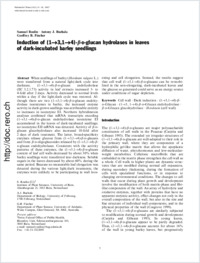Induction of (1→3,1→4)-ß-D-Glucan hydrolases in leaves of dark-incubated barley seedlings
- Roulin, Samuel Institute of Plant Sciences, University of Bern, Switzerland - Swiss Federal Office of Public Health, Biosafety Unit, Bern, Switzerland
- Buchala, Antony J. Department of Biology, University of Fribourg, Switzerland
- Fincher, Geoffrey B. Department of Plant Science, University of Adelaide, Australia
-
26.01.2002
Published in:
- Planta. - 2002, vol. 215, no. 1, p. 51-59
Cell wall
Dark induction
(1→3,1→4)-β-D-Glucan
(1→3,1→4)-β-D-Glucan endohydrolase
β-D-Glucan glucohydrolase
Hordeum (cell wall)
English
When seedlings of barley (Hordeum vulgare L.) were transferred from a natural light/dark cycle into darkness, (1M3,1M4)-#-D-glucan endohydrolase (EC 3.2.1.73) activity in leaf extracts increased 3- to 4-fold after 2 days. Activity decreased to normal levels within a day if the light/dark cycle was restored. Although there are two (1M3,1M4)-#-D-glucan endohydrolase isoenzymes in barley, the increased enzyme activity in dark-grown seedlings was attributable entirely to increases in isoenzyme EI. Northern hybridization analyses confirmed that mRNA transcripts encoding (1M3,1M4)-#-D-glucan endohydrolase isoenzyme EI accumulated in the leaves of dark-incubated seedlings; no isoenzyme EII mRNA was detected. Activity of #-D-glucan glucohydrolases also increased 10-fold after 2 days of dark treatment. The latter, broad-specificity enzymes release glucose from (1M3,1M4)-#-D-glucans and from #-D-oligoglucosides released by (1M3,1M4)-#-D-glucan endohydrolases. Consistent with the activity patterns of these enzymes, the (1M3,1M4)-#-D-glucan content of leaf cell walls decreased by about 30% when barley seedlings were transferred into darkness. Soluble sugars in the leaves decreased by about 60% during the same period. Because no measurable leaf elongation was detected during the various light/dark treatments, the enzymes were unlikely to be participating in wall loosening and cell elongation. Instead, the results suggest that cell wall (1M3,1M4)-#-D-glucans can be re- mobilized in the non-elongating, dark-incubated leaves and the glucose so generated could serve as an energy source under conditions of sugar depletion.
- Faculty
- Faculté des sciences et de médecine
- Department
- Département de Biologie
- Language
-
- English
- Classification
- Biological sciences
- License
- License undefined
- Identifiers
-
- RERO DOC 5510
- DOI 10.1007/s00425-001-0721-1
- Persistent URL
- https://folia.unifr.ch/unifr/documents/299982
Statistics
Document views: 156
File downloads:
- 1_buchala_ichl.pdf: 196
